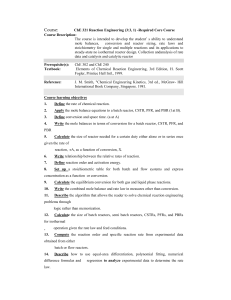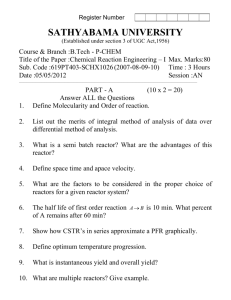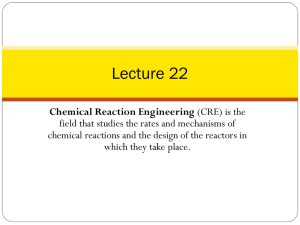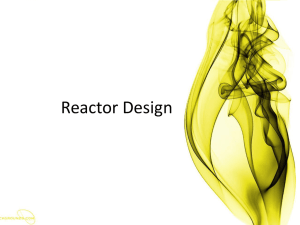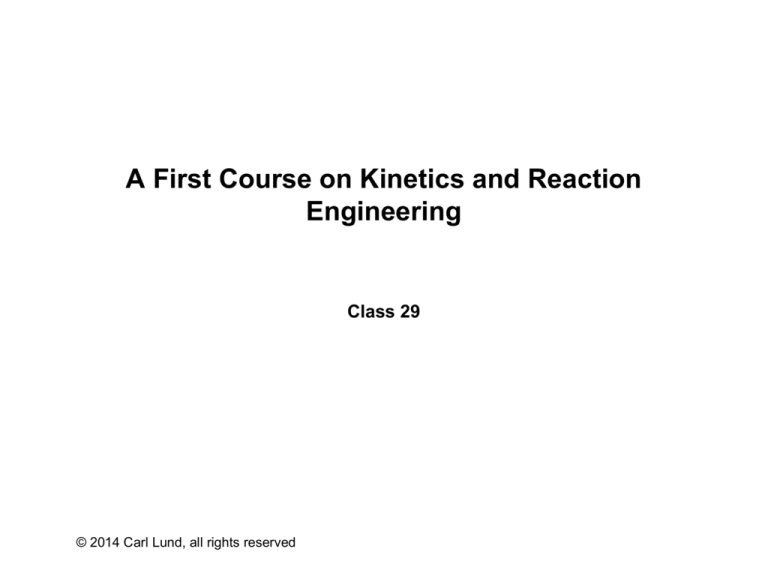
A First Course on Kinetics and Reaction
Engineering
Class 29
© 2014 Carl Lund, all rights reserved
Where We’re Going
• Part I - Chemical Reactions
• Part II - Chemical Reaction Kinetics
• Part III - Chemical Reaction Engineering
‣ A. Ideal Reactors
‣ B. Perfectly Mixed Batch Reactors
‣ C. Continuous Flow Stirred Tank Reactors
‣ D. Plug Flow Reactors
-
25. Reaction Engineering of PFRs
26. Analysis of Steady State PFRs
27. Analysis of Transient PFRs
‣ E. Matching Reactors to Reactions
-
28. Choosing a Reactor Type
29. Multiple Reactor Networks
30. Thermal Back-Mixing in a PFR
31. Back-Mixing in a PFR via Recycle
32. Ideal Semi-Batch Reactors
• Part IV - Non-Ideal Reactions and Reactors
Reactor Networks
Series
• Reasons for using multiple reactors
‣ Add capacity to an existing process
‣ Performance Advantages
-
Heat management
More favorable composition vs. space time
• No difference in model for an individual reactor
‣ Equations may become coupled with those for another reactor
‣ May need additional mole and energy balances at splitting and
mixing points
• General behavior
‣ Two PFRs (of equal diameter) connected in series are equivalent to
a single PFR with their combined length provided no heating, cooling
or fluid exchange takes place between them
‣ Mixing two streams of unequal conversion generally decreases the
performance of a parallel reactor network compared to networks
where such mixing does not occur
• CSTR cascades (CSTRs in series)
‣ As the number of CSTRs in the cascade increases, keeping total
volume constant, the cascade performs more and more like a PFR
Parallel
Advantage of a CSTR Cascade over a Single
CSTR
Inlet composition
and temperatures
are equal
Outlet composition
and temperatures
are equal
Rates are
Equal
Rate is
Higher
Since some of the reaction occurs
at a higher rate with 2 reactors
the total volume is smaller
Questions?
Activity 29
• Consider the irreversible, liquid phase reaction A → B which occurs at
constant density. Reactant A is supplied at a rate of 4 L min-1 in a
concentration of 2 mol L-1 and at a temperature of 43 ºC. The heat
capacity of the fluid is 0.87 cal mL-1 K-1 and the heat of reaction is -27.2
kcal mol-1. The reaction is second order in the concentration of A, and the
rate coefficient obeys Arrhenius’ law with a pre-exponential factor of 6.37
x 109 L mol-1 min-1 and an activation energy of 14.3 kcal mol-1. It is desired
to convert 90% of the reactant to product adiabatically. Consider the
following reactor networks: (a) a single CSTR, (b) a single PFR, (c) two
CSTRs in series, (d) a CSTR followed in series by a PFR, and (e) a PFR
followed in series by a CSTR. Determine which reactor network requires
the smallest total reactor volume. (In each of the reactor networks, the two
reactors are not required to have equal volumes.)
Activity 29
• Consider the irreversible, liquid phase reaction A → B which occurs at
constant density. Reactant A is supplied at a rate of 4 L min-1 in a
concentration of 2 mol L-1 and at a temperature of 43 ºC. The heat
capacity of the fluid is 0.87 cal mL-1 K-1 and the heat of reaction is -27.2
kcal mol-1. The reaction is second order in the concentration of A, and the
rate coefficient obeys Arrhenius’ law with a pre-exponential factor of 6.37
x 109 L mol-1 min-1 and an activation energy of 14.3 kcal mol-1. It is desired
to convert 90% of the reactant to product adiabatically. Consider the
following reactor networks: (a) a single CSTR, (b) a single PFR, (c) two
CSTRs in series, (d) a CSTR followed in series by a PFR, and (e) a PFR
followed in series by a CSTR. Determine which reactor network requires
the smallest total reactor volume. (In each of the reactor networks, the two
reactors are not required to have equal volumes.)
• Start with a qualitative analysis
‣ How will the rate change as the space time increases?
‣ Which of the reactors or reactor networks is better suited to the rate versus conversion profile
-
When the rate is larger, the required volume is smaller
Qualitative Analysis
• The reaction is exothermic and irreversible
‣ As conversion increases, the rate will increase, pass through a maximum and then decrease
• You can’t say for sure which reactor or network is preferred because you
don’t know what conversion corresponds to the maximum rate
‣ If the maximum rate occurs near 90% conversion, a single CSTR would probably be best
because throughout the reactor, the rate would be high, leading to a smaller volume
‣ If the maximum rate occurs at conversions well below 90%, a CSTR sized to operate at near
the maximum rate followed by a PFR would probably be best
• Note, a PFR always operates right on the rate versus space time (or
conversion) curve
‣ In a conversion range where the rate is continually increasing, a CSTR will be smaller
‣ In a conversion range where the rate is continually decreasing, a PFR will be smaller
• Now proceed to the quantitative analysis of the five cases
‣ Write design equations for each reactor in the network
‣ Identify each flow stream (a, b, c, etc.) and determine whether the molar flows and the
temperature are known
‣ Solve the design equations to find the reactor volume or volumes
-
When there are two reactors, pick the volume of the first reactor, solve the equations for
the total volume and repeat
-
Plot the total volume versus the volume of the first reactor to find the minimum
Design Equations
• Write design equations that
can be used to analyze any of
the CSTRs
Design Equations
• Write design equations that
can be used to analyze any of
the CSTRs
‣
• Write design equations that
can be used to analyze any of
the PFRs
‣
‣
‣
‣
æ -E ö 2
- rout = k0 exp ç
C A,out
÷
è RTout ø
‣ 3 equations, so 3 unknowns
- ṅB,out and Tout in all cases
- ṅA,out when CSTR is the first
-
reactor
V when CSTR is the second
reactor
‣
-
æ -E ö 2
rout = k0 exp ç
CA
÷
è RT ø
‣ Final condition
- V when PFR is the first reactor
- ṅA,out when PFR is the second
reactor
Individual Reactors
• For every CSTR
‣ Design equations from previous slide
‣ ṅB,out and Tout are unknown
• For first CSTR if there are 2
reactors
‣ ṅA,out is unknown
• For last CSTR
‣ V is unknown
• For every PFR
‣ Design equations and initial conditions
from previous slide
• For first PFR if there are 2 reactors
‣ Final value is V
• For last PFR
‣ Final value is ṅA,out
Numerical Solution
• For the single reactors, simply solve the design equations to find V
• For each reactor network
‣ Pick a range of values for the first reactor volume between zero and the volume of the single
reactor found above
‣ For each volume in that range
-
Solve the design equations for the first reactor to get molar flow rates of A and B and
temperature for stream b in diagrams
-
Use those results to solve the design equations for the second reactor to get its volume
Calculate the total volume and plot it versus the volume of the first reactor
‣ Find the minimum in the plot and from it, read the minimum volume for that reactor network
• Solving the CSTR design equations requires a guess for the solution
‣ It may be difficult or impossible to find a single guess that works over the whole range of
volumes
-
Either solve over smaller ranges of volume
Or write the code so the guesses are varied appropriately
Numerical Solution
• For the single reactors, simply solve the design equations to find V
• For each reactor network
‣ Pick a range of values for the first reactor volume between zero and the volume of the single
reactor found above
‣ For each volume in that range
-
Solve the design equations for the first reactor to get molar flow rates of A and B and
temperature for stream b in diagrams
-
Use those results to solve the design equations for the second reactor to get its volume
Calculate the total volume and plot it versus the volume of the first reactor
‣ Find the minimum in the plot and from it, read the minimum volume for that reactor network
• Solving the CSTR design equations requires a guess for the solution
‣ It may be difficult or impossible to find a single guess that works over the whole range of
volumes
-
Either solve over smaller ranges of volume
Or write the code so the guesses are varied appropriately
• Results from smallest to largest
‣ Single CSTR (7.0 L) > 2 CSTRs (2.7 L) > single PFR = PFR before CSTR (1.7 L) > CSTR
before PFR (1.5 L)
Volume Plots
Where We’re Going
• Part I - Chemical Reactions
• Part II - Chemical Reaction Kinetics
• Part III - Chemical Reaction Engineering
‣ A. Ideal Reactors
‣ B. Perfectly Mixed Batch Reactors
‣ C. Continuous Flow Stirred Tank Reactors
‣ D. Plug Flow Reactors
-
25. Reaction Engineering of PFRs
26. Analysis of Steady State PFRs
27. Analysis of Transient PFRs
‣ E. Matching Reactors to Reactions
-
28. Choosing a Reactor Type
29. Multiple Reactor Networks
30. Thermal Back-Mixing in a PFR
31. Back-Mixing in a PFR via Recycle
32. Ideal Semi-Batch Reactors
• Part IV - Non-Ideal Reactions and Reactors

